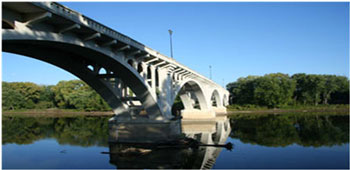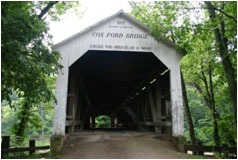INDIANA DEPARTMENT OF TRANSPORTATION
Historic Bridges Management Program
Program Description

Lincoln Memorial Bridge and the George Rogers Clark Bridge, 1932,
Knox County, Indiana.
(Source: Indiana Department of Transportation.)
Program Benefits
- This historic bridge management program provides state and local transportation planners with the historic preservation requirements for any historic bridge that may fall within a project planning area.
- In the past, disagreements on the National Register eligibility of bridges and disagreements about the preferred alternative often slowed down projects. As a result of the current program, however, all parties now know which bridges are National Register-eligible; and, they know which bridges are most suitable for preservation and which bridges are not.
- The program has streamlined the process for addressing impacts to historic bridges, resulting in less time and money spent on consultation and mitigation measures.
Indiana DOT (INDOT) has developed a proactive program for managing all of the State’s National Register-eligible and listed publicly-owned bridges. The structure of this program was stipulated in a Section 106 programmatic agreement (PA) executed in the fall of 2006. The PA stipulates that the program will be revisited every 10 years to see if changes or updates are needed.
After the completion of a statewide historic bridge inventory, INDOT, in consultation with their Section 106 consulting parties, stakeholders, and the public, developed a structured methodology for identifying National Register-eligible and listed bridges most suitable for preservation and that are excellent examples of a given historic bridge type. Bridges that met these criteria were identified as “Select Bridges.” All other National Register-eligible and listed bridges were placed in a “Non-Select” category. Indiana DOT and the Federal Highway Administration (FHWA) have completed their in-house identification of Select and Non-Select Bridges.
Setting Up the Program
Creating this program was a joint effort among the FHWA, INDOT, the Indiana State Historic Preservation Office (SHPO), representatives of local historic bridge interest groups, the Advisory Council on Historic Preservation, counties, other stakeholders, and one of Indiana’s U.S. Senators. This was a group effort, involving a task force that met several times during the development phase of the program. All of these parties participated in the development and execution of the PA establishing the program.
State Planning and Research (SPR) funds were used to develop the program. FHWA and INDOT came to an agreement that this historic bridge program was a critical transportation planning tool, so the use of SPR funds was considered appropriate. The INDOT used these funds to update and complete the statewide inventory of historic bridges on public roads and on public rights-of-way. These funds also were used to hire a consultant to do most of the program’s ground work. Given the cost, however, the program was developed incrementally.
The first step in developing the program involved creating a statewide historic context on historic bridges. This context was the foundation for determining which bridges were eligible for listing in the National Register. The FHWA and INDOT, working with the consulting parties and the public, then identified the Select and Non-Select Bridges.
Challenges Encountered
Program Elements
- Historic Preservation
in Transportation Planning
- Historic Preservation in Early
Project Development
- Interagency Cooperation
and Collaboration
- Geographic Information Systems
- Historic Property Database
- Programmatic Approaches
to Identifying, Evaluating,
and Managing Historic Properties
During the development of the program, preservation organizations and bridge owners pressed their own respective agendas. Frequent and open consultation led to the creation of filtering criteria that were applied to all historic bridges, and resulted in a balanced list of Select and Non-Select bridges.
Another challenge was how to deal with Section 4(f) in the context of identifying and treating Select versus Non-Select Bridges. This issue was resolved in part by including a statement in the PA that FHWA will not consider demolition to be a “prudent” alternative for any Federal-aid project involving a Select Bridge.
Program Maintenance

Parke County Bridge No. 227, Burr arch truss, 1913.
(Source: Indiana Department of Transportation.)
Since the conclusion of the inventory portion of the program, no further SPR funds have been used. Funding for the individual bridge projects comes through regular funding sources as bridge owners propose projects (e.g., Bridge Replacement funds). The PA also stipulates that Select Bridges receive “funding priority…within the historic projects category” of the Transportation Enhancement program.
Many owners indicate a desire to preserve their historic bridges but cite great difficulty in simply maintaining their regular infrastructure, let alone historic infrastructure, which costs more in some cases.
Critical Factors for a Successful Program
The most important factor in the success of the program is effective communication with the bridge owners about the program requirements.
If the program were starting up today the only recommended change would be the setting aside of funds for the rehabilitation of Select Bridges regardless of use (e.g., continued vehicular use, pedestrian, etc.).
June 1, 2012

